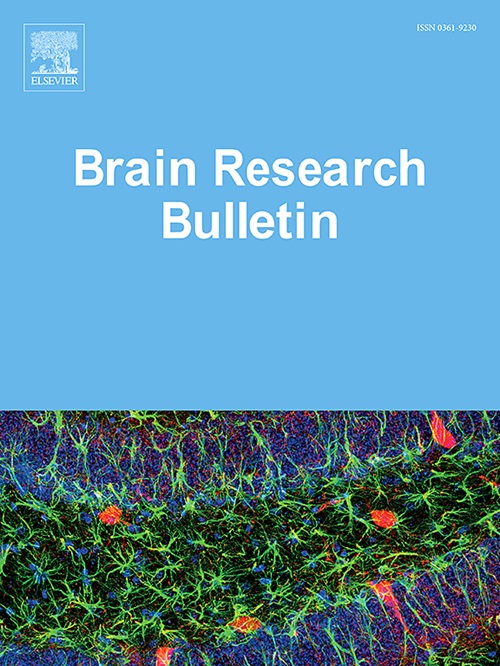单细胞转录组测序分析急性缺血再灌注后星形胶质细胞的反应及其与周围脑细胞的相互作用
IF 3.5
3区 医学
Q2 NEUROSCIENCES
引用次数: 0
摘要
星形胶质细胞在缺血性脑卒中的发生发展中起关键作用。然而,反应性星形胶质细胞在缺血性卒中中既有保护作用,也有有害作用。遗憾的是,与星形胶质细胞转化为不同亚簇相关的刺激信号缺乏系统的分析,星形胶质细胞产生多重作用的机制也不完全清楚。我们通过单细胞RNA测序研究小鼠脑缺血再灌注后星形胶质细胞12 h的异质性,并通过逆转录-聚合酶链反应验证基因表达。我们获得了星形胶质细胞亚簇涉及多种功能的转录特征。为了探索刺激信号导致星形胶质细胞异质性的原因,我们绘制了缺血再灌注后星形胶质细胞亚簇与周围其他脑细胞12 h之间的细胞通讯蓝图,并鉴定了9个潜在和有希望成为治疗靶点的基因和6个星形胶质细胞亚簇2特异性的基因,这些基因倾向于抵抗缺血再灌注损伤。缺血-再灌注后12 h,星形胶质细胞的每个亚簇在功能和与周围细胞的通讯方面具有特征,这是基于我们通过亚簇特征揭示的激活基因和转录分子。我们的研究结果为揭示星形胶质细胞对脑缺血再灌注的抗损伤反应提供了基础,该反应涉及不同亚簇的协调以及星形胶质细胞与周围脑细胞的协调。本文章由计算机程序翻译,如有差异,请以英文原文为准。
Response of astrocytes and their interaction with surrounding brain cells after acute ischemia-reperfusion analyzed by single-cell transcriptome sequencing
Astrocytes play a key role in the occurrence and development of ischemic stroke. However, reactive astrocytes have both detrimental and protective roles in ischemic stroke. Regrettably, the stimulation signals associated with the transformation of astrocytes into different subclusters lack systemic analysis, and the mechanism by which astrocytes produce multiple effects is not entirely clear. We investigated the heterogeneity of mouse astrocytes 12 h after cerebral ischemia-reperfusion via Single-cell RNA sequencing and verified gene expressions by reverse transcription-polymerase chain reaction. We acquired astrocyte subclusters’ transcriptional characteristics involved in diversified functions. To explore what stimulus signals cause astrocyte heterogeneity, we present a blueprint for cellular communication between astrocyte subclusters and other surrounding brain cells 12 h after ischemia-reperfusion, and identified 9 genes which are potential and promising for being therapeutic targets and 6 genes were specific to astrocyte subcluster 2 that tend to resist ischemia-reperfusion injury. At 12 h after ischemia-reperfusion, each subcluster of astrocytes is characteristic in terms of function and communication with surrounding cells, which is based on the activation genes and transcription molecules that we have revealed with subcluster characteristics. Our results provide a basis for revealing the anti-injury response of astrocytes to cerebral ischemia-reperfusion, which involves coordination of different subclusters and the coordination of astrocytes with surrounding brain cells.
求助全文
通过发布文献求助,成功后即可免费获取论文全文。
去求助
来源期刊

Brain Research Bulletin
医学-神经科学
CiteScore
6.90
自引率
2.60%
发文量
253
审稿时长
67 days
期刊介绍:
The Brain Research Bulletin (BRB) aims to publish novel work that advances our knowledge of molecular and cellular mechanisms that underlie neural network properties associated with behavior, cognition and other brain functions during neurodevelopment and in the adult. Although clinical research is out of the Journal''s scope, the BRB also aims to publish translation research that provides insight into biological mechanisms and processes associated with neurodegeneration mechanisms, neurological diseases and neuropsychiatric disorders. The Journal is especially interested in research using novel methodologies, such as optogenetics, multielectrode array recordings and life imaging in wild-type and genetically-modified animal models, with the goal to advance our understanding of how neurons, glia and networks function in vivo.
 求助内容:
求助内容: 应助结果提醒方式:
应助结果提醒方式:


